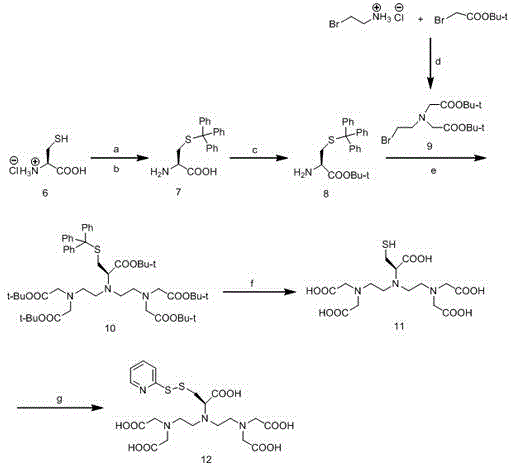Design ad synthesis method for DTPA (Diethylene Triamine Pentacetic Acid) analogue for paramagnetic labeling of proteins
A paramagnetic labeling and protein technology, which is applied in the analysis of electron paramagnetic resonance, the preparation method of peptides, organic chemistry, etc. And other issues
- Summary
- Abstract
- Description
- Claims
- Application Information
AI Technical Summary
Problems solved by technology
Method used
Image
Examples
Embodiment 1
[0046] Example 1 Synthetic label
[0047] (1) S-trityl-L-cysteine, namely figure 2 Synthesis of Compound 7 in
[0048] Add 10.0g (63.50mmol) of L-cysteine hydrochloride, 15.80g (56.68mmol) of triphenylchloromethane, and 75.0ml of DMF into a 250ml single-necked bottle, stir at room temperature for 20-30h, pour it into 10 % NaOAc solution, a white solid precipitated, filtered, washed the filter cake with deionized water, recrystallized the filter cake in anhydrous acetone, filtered after cooling, washed the filter cake with anhydrous acetone and anhydrous ether, and dried by infrared , to obtain white powder 7.21g, yield: 34.8%. 1 H-NMR (400 MHz, DMSO-d 6 ) δ ppm: 7.24-7.37 (15H, m), 2.92 (1H, dd, J = 9.2Hz, 4.2Hz), 2.58 (1H,dd, J = 12.5Hz, 4.2Hz), 2.40 (1H,dd, J = 12.5Hz, 9.2Hz).
[0049] (2) S-trityl-L-cysteine tert-butyl ester, namely figure 2 Synthesis of Compound 8 in
[0050] Add 1.51g (4.16mmol) of 7 and 24.5ml of tert-butyl acetate into a 100ml th...
Embodiment 2
[0059] Example 2 Paramagnetic label DTPA-CH 2 Application of S-SPy
[0060] The protein used to attach the tag is 15 The mutant of N-labeled human ubiquitin protein ubiquitin (Ubi): ubiquitin G47C, which uses the cysteine sulfhydryl group of the mutant to exchange the disulfide bond of the paramagnetic label to achieve the purpose of connection. image 3 is the connection mode of protein and paramagnetic label. The specific connection process is as follows:
[0061] (1): Configure 50 mM DTPA-CH 2 S-SPy label solution: Weigh it quantitatively, add MQ ultrapure water, and dissolve.
[0062] (2): Gradually add the protein dropwise to five times the amount of the labeling solution to ensure that the reaction pH is about 6.4, react for 1~2 hours, pass through the PD10 desalting column, remove small molecules, and obtain the final product, which is the protein solution with the label attached. If the label cannot be removed, it can be separated by DEAE anion exchange column. ...
Embodiment 3
[0065] Example 3 Paramagnetic label DTPA-CH 2 Application of S-SPy
[0066] The reaction pH was 3.0, and the rest of the steps were the same as in Example 2.
[0067] The result of embodiment 2 and embodiment 3 is as Figure 4 , 5 , 6 and 7 show:
[0068] Figure 4 0.1 mM ubiquitin G47C and 0.1 mM complex ubiquitin G47C-DTPA at 25℃, pH=6.4 1 H- 15 Overlay of N HSQC spectra, gray indicates the spectrum of the complex ubiquitin G47C-DTPA. The amino acid residues marked in the spectrum are residues with large chemical shifts after the protein is attached to the label, which shows that most of the amino acid residues overlap well, and only the amino acid residues near G47C have a large change, indicating that paramagnetic The introduction of tags did not have much impact on the protein structure.
[0069] Figure 5 0.1 mM ubiquitin G47C and 0.1 mM complex ubiquitin G47C-DTPA at 25℃, pH=3.0 1 H- 15 Overlay of N HSQC spectra, gray indicates the spectrum of the complex ubi...
PUM
 Login to View More
Login to View More Abstract
Description
Claims
Application Information
 Login to View More
Login to View More - R&D
- Intellectual Property
- Life Sciences
- Materials
- Tech Scout
- Unparalleled Data Quality
- Higher Quality Content
- 60% Fewer Hallucinations
Browse by: Latest US Patents, China's latest patents, Technical Efficacy Thesaurus, Application Domain, Technology Topic, Popular Technical Reports.
© 2025 PatSnap. All rights reserved.Legal|Privacy policy|Modern Slavery Act Transparency Statement|Sitemap|About US| Contact US: help@patsnap.com



